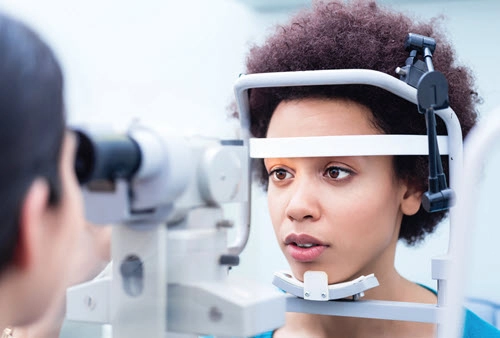Check These 4 Essential FAQ Answers for Clean Eye Care Coding
Part B reps answered several burning questions during a recent session. Are you vexed by bilateral coding issues? Do you face denials when dealing with cataract aftercare claims?? The answer to both questions can vary based on your circumstances, and you should know the nuances that will allow you to most accurately report these services. That was the word from CGS Medicare’s Towanna Tripp during the payer’s January 21, 2021 “Frequently Asked Question” webinar. She revealed the answers to four pressing community questions during the session, and we’ve got the updates most applicable to eye care practices. Question 1: Do MACs Need Prior Authorizations? One way that many eye care practices maximize income is to get prior authorization for many services. This allows you to confirm that your work will be reimbursed, and can typically help you determine the patient responsibility. However, Tripp said, it’s not always required. “For Medicare Part B, all services are allowed based on medical necessity,” she said. “This means you bill your services to us, and based on the diagnosis on your claim, we’re going to decide whether to allow that service. We often get questions requesting prior authorization for advanced imaging services like CT scans or MRIs. We do not require prior authorizations for these. The only things in Part B that do require prior authorizations are certain DME services and for certain Part A outpatient department services,” she noted. Tripp’s statement is supported by CMS. In MLN Bulletin SE0916, the agency notes, “Medicare coverage and payment for items and services is contingent upon a determination that an item and service: Note this eye care-specific exception: As of July 1, 2020, prior authorization is required for certain hospital outpatient procedures, Tripp said, and among these are blepharoplasty procedures. That’s because this service can be considered medically necessary or cosmetic, which is what prompted the prior authorization requirement, Tripp said. The hospital outpatient department submits the prior authorization request to ensure that the procedure can be paid after the service is rendered. Question 2: When Can We Perform the Annual Wellness Visit (AWV)? In some cases, patients with conditions like glaucoma or macular degeneration may only visit the ophthalmologist each year, not making time to see other physicians. Therefore, the ophthalmologist might opt to perform an annual wellness visit (AWV) to ensure that the patient’s overall health profile is taken into consideration. However, these services have very specific guidelines surrounding them, Tripp said. “Before scheduling an AWV, check the patient’s eligibility information,” she noted. “The AWV is covered when the beneficiary is no longer within the 12 months after the patient’s Part B benefits eligibility date AND has not received an initial preventive physical exam (IPPE) or an AWV within the past 12 months,” she said. “If you try to bill an AWV within the patient’s first 12 months of beginning Part B, our system is going to reject that because the patient hasn’t been in the Medicare program long enough to have an AWV,” she said. Some patients may say they have been on Medicare for years but haven’t had an annual exam, but then you report an AWV and face a denial. In these situations, perhaps the patient forgot to tell you they had an AWV six months ago, because they didn’t realize that’s what it was. If it’s billed within 12 months of the previous one, the claim will be denied, she said. To avoid these denials, you can check your MAC’s online system to determine when a patient is next available for another AWV, or the patient can call and check that information themselves, but it should always be checked before scheduling. “Because if we don’t pay for it, we deny it and we give it patient responsibility — and a lot of times, they complain and say they never had it and they don’t want to pay you, so it could be hard to get your money,” she noted. Question 3: Our Physician Rendered Postop Care Only — Why Are Our Claims Being Denied? It happens from time to time: Patients may go to another city for a surgery, such as a cataract excision, and then return to their hometown, where your eye care specialist will handle the postoperative care. Getting paid for postop care only can be tricky, Tripp noted. In these cases, physicians other than surgeons who are providing postoperative care should use modifier 55 (Postoperative management only) for procedures with global periods of 10 or 90 days, Tripp said. “Report the date of surgery as the date of service (DOS), not when you first saw the patient.” For instance, perhaps the patient had surgery on Jan. 1, but you didn’t see them until Jan. 9. The DOS is Jan. 1, not Jan. 9, she said. “Indicate the ‘assumed’ and ‘relinquished’ information in item 19 of the claim form, she noted. “The receiving physician must provide at least one service before billing any part of the postoperative care,” she noted. “So, if the patient had surgery on Jan. 1, you can’t bill us on Jan. 2 for the postop care. You have to wait to see the patient first before doing that.” The surgeon who performed the surgery may forget to put modifier 54 (Surgical care only) on their claim. “They may have relinquished the postop care to your physician, but they forgot to bill their surgery claim with the 54 modifier, so when that comes in, we have no idea whether the surgeon relinquished their care until you bill your claim,” Tripp said regarding the payer’s perspective. “By this time the surgeon has already gotten paid, not only for the surgery but also for the postop. They got paid for the entire global package.” To correct this, you must contact the surgeon and let them know they made an error and received the money for the postop care. They will have to send a correction to the insurer’s overpayment recovery department so they can recoup that portion of the claim. “They have to bill it with the 54 modifier and we can adjust the claim and recoup our money back and once that’s done, you’ll be able to bill your claim for the postop care,” she said. “Make sure you’re working closely with the surgeon’s office, and that they’re getting their info in as soon as possible, because even though they got paid for the postop care, your claim is being rejected for a billing error, so you’re on a time limit to get that claim into us within a year from the DOS so you can get your payment.” If the surgery occurred in another state, indicate that in block 19, she advised. Some issues stem from the fact that the surgery was in one state and the postop care was in another, which should be made clear to the MAC so the processors know to verify that the out of state provider billed the claim correctly as well. Question 4: How Many Units Should I Submit When Using Modifier 50? “When billing the 50 modifier (Bilateral procedure) to report a bilateral procedure, performed in the same operative session, the unit (quantity field) must be ‘1,’” Tripp said. “You’re only billing for one bilateral procedure, so therefore you should only be billing one unit, it’s as simple as that,” she said. Report the procedure on one line of the claim form, and if you use modifier 50, don’t also use the RT (Right side) or LT (Left side) modifiers, she said. In addition, if the code descriptor already uses the term “bilateral,” it doesn’t need modifier 50, since those are inherently bilateral. “This isn’t usually required for X-rays,” she said. “For X-rays, you can just bill two units.”



